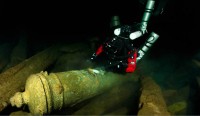 Divers have found a 16th century shipwreck in the Baltic 11 miles north of the Swedish island of Oland. Although detailed exploration is necessary before they can confirm it, preliminary examination indicates that it is the wreck of the warship Mars, flagship of King Erik XIV’s fleet which sank during a battle with Denmark in 1564. That would make this ship 64 years older than the Vasa, Sweden’s famously intact wreck salvaged from Stockholm Bay 50 years ago, and just 19 years older than Tudor England’s Mary Rose.
Divers have found a 16th century shipwreck in the Baltic 11 miles north of the Swedish island of Oland. Although detailed exploration is necessary before they can confirm it, preliminary examination indicates that it is the wreck of the warship Mars, flagship of King Erik XIV’s fleet which sank during a battle with Denmark in 1564. That would make this ship 64 years older than the Vasa, Sweden’s famously intact wreck salvaged from Stockholm Bay 50 years ago, and just 19 years older than Tudor England’s Mary Rose.
 The Mars was even bigger than the Vasa. It carried 107 guns and a crew of 800, and unlike the Vasa which was poorly constructed and sank on its maiden voyage, Mars actually took those cannon and sailors to war. King Eric, of tenuous sanity but substantial ambition, sought to expand Sweden’s territories in the eastern Baltic, dominated at that time by his cousin Frederick II of Denmark. In 1563 tensions exploded into the Northern Seven Years’ War between Sweden on one side and Denmark–Norway, Lübeck and the Polish–Lithuanian union on the other.
The Mars was even bigger than the Vasa. It carried 107 guns and a crew of 800, and unlike the Vasa which was poorly constructed and sank on its maiden voyage, Mars actually took those cannon and sailors to war. King Eric, of tenuous sanity but substantial ambition, sought to expand Sweden’s territories in the eastern Baltic, dominated at that time by his cousin Frederick II of Denmark. In 1563 tensions exploded into the Northern Seven Years’ War between Sweden on one side and Denmark–Norway, Lübeck and the Polish–Lithuanian union on the other.
The shipwreck was discovered at a depth of 75 metres [246 feet], near the northern promontory of the Baltic island of Öland off of Sweden’s east coast. The wreckage is reportedly solid oak and the seabed is strewn with bronze cannons.
The Mars was the largest ship in the Baltic in its heyday and was sunk, only a year after its maiden voyage, during a sea battle with the Danish-Lübeckian navy in 1564.
After two days of ferocious fighting, Mars was hit by cannon fire and went up in smoke. In the ensuing kerfuffle the vessel went down and has been resting untouched in its watery grave for 447 years.
 The wreck is the proper size and age to be the Mars, and no other ships of its kind went down between Gotland and Oland at that time. Divers also found a sheaf of corn engraved on one of the cannons, the emblem of the House of Vasa, the Swedish royal family in the 16th and 17th centuries. That same emblem can be found on the lower stern of the warship Vasa, embraced by two putti.
The wreck is the proper size and age to be the Mars, and no other ships of its kind went down between Gotland and Oland at that time. Divers also found a sheaf of corn engraved on one of the cannons, the emblem of the House of Vasa, the Swedish royal family in the 16th and 17th centuries. That same emblem can be found on the lower stern of the warship Vasa, embraced by two putti.
The wreck appears to be well-preserved, divers say, with a hole in its side but otherwise in good condition thanks to the cold waters of the Baltic. Swedish divers have been looking for the Mars for decades, so the team is in seventh heaven.
For wreck-diver Lundgren, finding the lost Mars would be like a boyhood dream come true.
“To discover a shipwreck is the dream of all divers, but to find Mars, which people have been searching for so long – it couldn’t get bigger than that. I am happy to be Swedish today!” he told The Local.
When it comes to ships from bygone times, there is nothing like seeing the real thing–and not just pieces of the wreck. Perhaps they can raise this one, too. It would have even more credibility than the Vasa.
For those of us who want a similar experience on this side of the ocean, the Mariner’s Museum in Hampton/Newport News, Virginia has the actual turret of the USS Monitor and a mock-up of the forward section of the CSS Merrimack. It’s worth a visit for this and many other very interesting exhibits.
They’re definitely hoping to raise it at some point, although of course that’s very much in the future.
Baltimore has the USS Constellation, a Civil War sloop largely constructed out of the previous USS Constellation made in the 1790s. It’s a ship with a rich and varied history. Very much worth a visit.
Amazing, can’t wait to read more about it!
Me too! Also to see all the neat underwater pictures that have yet to be published.
The Constellation? Or the USS Constitution? The USS Constitution was a ship I got to take a tour of when I was a kid. I think it was the first flag ship of the US Navy, but forget it’s history now. (Google would help, but don’t hae time to look it up right now.)